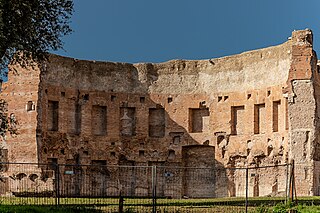
A bain-marie, a type of heated bath, is a piece of equipment used in science, industry, and cooking to heat materials gently or to keep materials warm over a period of time. A bain-marie is also used to melt ingredients for cooking.

In biology, taxonomy is the scientific study of naming, defining (circumscribing) and classifying groups of biological organisms based on shared characteristics. Organisms are grouped into taxa and these groups are given a taxonomic rank; groups of a given rank can be aggregated to form a more inclusive group of higher rank, thus creating a taxonomic hierarchy. The principal ranks in modern use are domain, kingdom, phylum, class, order, family, genus, and species. The Swedish botanist Carl Linnaeus is regarded as the founder of the current system of taxonomy, as he developed a ranked system known as Linnaean taxonomy for categorizing organisms and binomial nomenclature for naming organisms.

A bathroom or washroom is a room, typically in a home or other residential building, that contains either a bathtub or a shower. The inclusion of a wash basin is common. In some parts of the world e.g. India, a toilet is typically included in the bathroom; in others, the toilet is typically given a dedicated room separate from the one allocated for personal hygiene activities. In North American English the word 'bathroom' is sometimes used to refer to any room in a residence that contains a toilet, regardless of the inclusion of a bath or shower.

In ancient Rome, thermae and balneae were facilities for bathing. Thermae usually refers to the large imperial bath complexes, while balneae were smaller-scale facilities, public or private, that existed in great numbers throughout Rome.

Balneotherapy is a method of treating diseases by bathing, a traditional medicine technique usually practiced at spas. Since ancient times, humans have used hot springs, public baths and thermal medicine for theraputic effects. While it is considered distinct from hydrotherapy, there are some overlaps in practice and in underlying principles. Balneotherapy may involve hot or cold water, massage through moving water, relaxation, or stimulation. Many mineral waters at spas are rich in particular minerals such as silica, sulfur, selenium, and radium. Medicinal clays are also widely used, a practice known as 'fangotherapy'.

The laconicum was the dry sweating room of the Roman thermae, contiguous to the caldarium or hot room. The name was given to it as being the only form of warm bath that the Spartans admitted. The laconicum was usually a circular room with niches in the axes of the diagonals and was covered by a conical roof with a circular opening at the top, according to Vitruvius, from which a brazen shield is suspended by chains, capable of being so lowered and raised as to regulate the temperature. The walls of the laconicum were plastered with marble stucco and painted blue with gold stars.

A sand bath is a common piece of laboratory equipment made from a container filled with heated sand. It is used to provide even heating for another container, most often during a chemical reaction.
Kostinbrod is a town in western Bulgaria. It is the seat of Kostinbrod Municipality. It is located 15 km west of the capital city of Sofia. It is located on two important transport corridors: Lom — Sofia — Thessaloniki and Sofia — Belgrade. The international railway line to Western Europe passes through the municipality, with a train stop at Kostinbrod Station.

Banyuls-sur-Mer is a commune in the Pyrénées-Orientales department in southern France. It was first settled by Greeks starting in 400 BCE.
Anthony Marais is an American writer, musician, and academic. His writing focuses on culture, alchemy and the tendency of people to follow delusions.

Bagno di Romagna is a comune (municipality) in the Province of Forlì-Cesena in the Italian region Emilia-Romagna, located about 90 kilometres (56 mi) southeast of Bologna and about 45 kilometres (28 mi) south of Forlì.

Casciana Terme is a town of 2,500 inhabitants in the comune of Casciana Terme Lari, in the province of Pisa, Tuscany, central Italy.

Bagnoregio is a comune (municipality) in the Province of Viterbo in the Italian region of Lazio, located about 90 kilometres (56 mi) northwest of Rome and about 28 kilometres (17 mi) north of Viterbo.

Bathing played a major part in ancient Roman culture and society. It was one of the most common daily activities and was practiced across a wide variety of social classes. Though many contemporary cultures see bathing as a very private activity conducted in the home, bathing in Rome was a communal activity. While the extremely wealthy could afford bathing facilities in their homes, private baths were very uncommon, and most people bathed in the communal baths (thermae). In some ways, these resembled modern-day destination spas as there were facilities for a variety of activities from exercising to sunbathing to swimming and massage.
Spiano is a frazione of the commune of Teramo in the Abruzzo Region of Italy. It sits about seven miles from Teramo on a hill that overlooks both the Tordino and the Vomano valleys.
In biology, a species is the basic unit of classification and a taxonomic rank of an organism, as well as a unit of biodiversity. A species is often defined as the largest group of organisms in which any two individuals of the appropriate sexes or mating types can produce fertile offspring, typically by sexual reproduction. Other ways of defining species include their karyotype, DNA sequence, morphology, behaviour or ecological niche. In addition, paleontologists use the concept of the chronospecies since fossil reproduction cannot be examined.

The Phaneropterinae, the sickle-bearing bush crickets or leaf katydids, are a subfamily of insects within the family Tettigoniidae. Nearly 2,060 species in 85 genera throughout the world are known. They are also known as false katydids or round-headed katydids.

The Insula dell'Ara Coeli is one of the few surviving examples of an insula, the kind of apartment blocks where many Roman city dwellers resided. It was built during the 2nd century AD, and rediscovered, under an old church, when Benito Mussolini initiated a plan for massive urban renewal of Rome's historic Capitoline Hill neighbourhood.
An animal bath or balneum animale is a medical treatment in which the skin or carcass of a freshly slaughtered animal is wrapped around the patient. The treatment's goal is transference of the animal's vitality to the patient, with the warmth of the treatment perhaps having a therapeutic effect. The treatment has been used since antiquity and was thought to be effective for lameness. The young Kaiser Wilhelm II had a left arm palsied from birth and was given this treatment.

The Domus Severiana is the modern name given to the final extension to the imperial palaces on the Palatine Hill in Rome, built to the south-east of the Stadium Palatinum in the Domus Augustana of Septimius Severus. It included the Baths of Septimius Severus.












